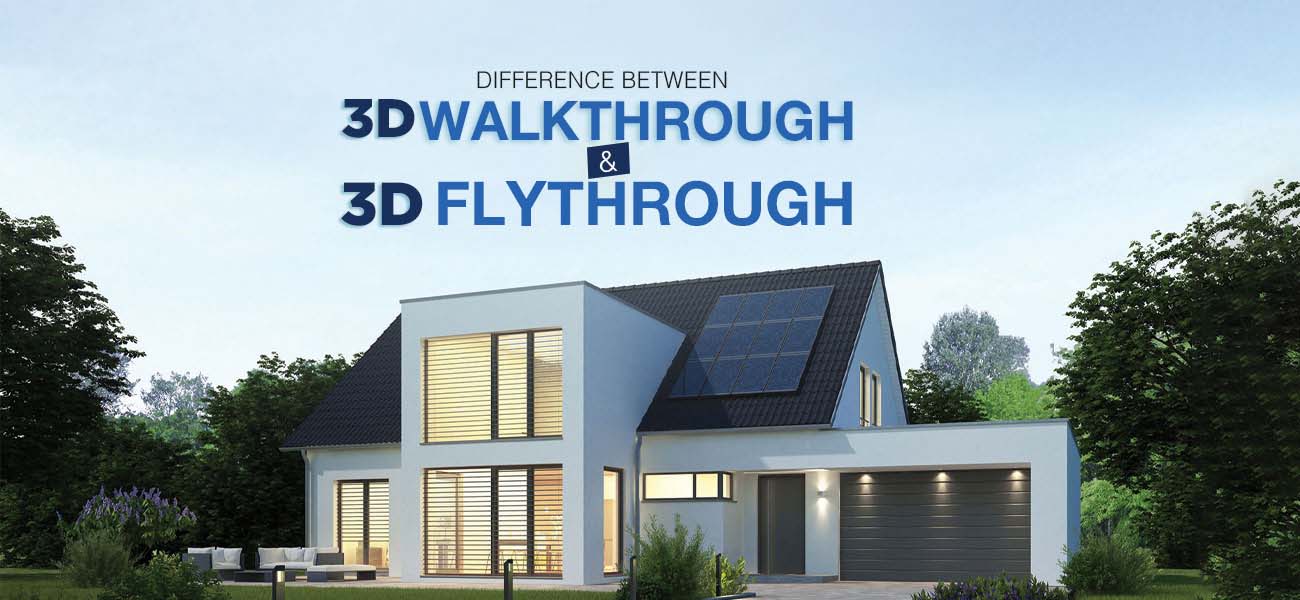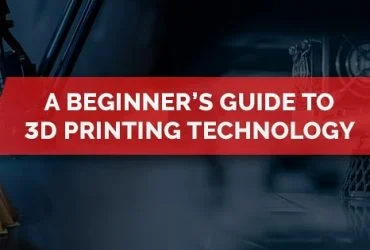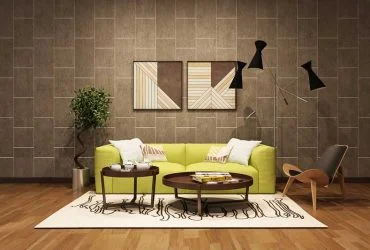Difference Between 3D Walkthrough Vs 3D Flythrough
When it comes to presenting architectural designs, real estate projects, or interior layouts, digital visualization techniques play a crucial role in bringing concepts to life. Two of the most popular methods used by designers and architects are walkthroughs and flythroughs. While both offer immersive experiences, they serve different purposes and create distinct visual effects.

Understanding the differences between 3D walkthroughs & 3D flythroughs can help architects, real estate developers, and marketers choose the best approach for their projects. So, what sets these visualization styles apart? Let us explore their unique characteristics, advantages, and applications in detail.
What is a 3D Walkthrough?
A 3D walkthrough is a highly detailed, interactive simulation that allows users to navigate a property space as if they were walking through it in real life. This technique is widely used in architectural design, real estate, and interior planning to provide an in-depth look at a property before construction begins. With the help of advanced 3D walkthrough services, designers can create lifelike environments where users can explore every corner of a building at their own pace.
Key Features of 3D Walkthroughs
-
User-Controlled Navigation
Unlike pre-rendered animations, an interactive 3D walkthrough allows users to move freely within a space, exploring various angles and perspectives.
-
Detailed Interiors
These visualizations focus on intricate interior elements, including furniture, textures, lighting, and decor.
-
Realistic Experience
Architectural 3D Walkthrough offers a lifelike representation of spaces, helping clients and stakeholders understand how a design will look and feel before it is built.
-
Enhanced Engagement
Real Estate 3D Walkthrough enables potential buyers to tour a property remotely, making it easier to visualize living or working in the space.
-
Customization Options
A company with 3D walkthrough experience can tailor experiences to include material selections, color changes, and design modifications based on client preferences.
-
Virtual Staging Possibilities
Walkthroughs can include virtual furniture staging, which helps real estate agents showcase unfurnished properties attractively.
-
Multiple Viewing Modes
Users can switch between day and night settings to see how lighting affects the ambiance of a space.
What is a 3D Flythrough?
A 3D flythrough is a cinematic animation that provides a sweeping, bird’s-eye view of an architecture project. Unlike a 3D walkthrough, which offers user-controlled exploration, a Cinematic 3D Flythrough follows a predetermined camera path, capturing stunning aerial perspectives and smooth transitions. This technique is often used to showcase large-scale architectural projects, urban developments, and master plans.
Key Features of 3D Flythroughs
-
Pre-Rendered Animation
A 3D Flythrough animation is a carefully choreographed sequence that highlights the grandeur of a project through seamless motion.
-
Expansive Views
These animations often include panoramic shots, aerial perspectives, and exterior flyovers to showcase the scale and layout of a development.
-
Cinematic Presentation
The smooth transitions, dramatic angles, and dynamic movements create a visually compelling experience.
-
Marketing Appeal
3D design services often use flythroughs in promotional videos, presentations, and investor pitches to generate excitement around a project.
-
Time-Efficient Viewing
Unlike interactive experiences, a flythrough delivers a concise yet comprehensive overview, making it ideal for quick presentations.
-
Storytelling Element
Flythroughs often include background music and voice overs, adding a narrative aspect to the visualization.
-
Multi-Platform Compatibility
These animations can be used in websites, presentations, social media, and advertisements, enhancing digital marketing efforts.
Key Differences Between 3D Walkthrough and 3D Flythrough
While both visualization techniques are effective, they cater to different objectives and audiences. Here’s a detailed comparison:
| Feature | 3D Walkthrough | 3D Flythrough |
|---|---|---|
| User Control | Fully interactive, users can navigate at their own pace | Pre-rendered, no user control |
| Perspective | First-person view, interior-focused | Aerial and exterior views, often sweeping wide angles |
| Detail Level | High-detail interiors, showcasing furniture, textures, and materials | Broad, cinematic scope, emphasizing overall structure and surroundings |
| Engagement | Highly engaging for buyers, allowing them to explore rooms and spaces | Captivating for presentations, ideal for showcasing large projects to investors. |
| Application | Used for interior design, real estate marketing, and architectural visualization. | Used for master plans, urban projects , and promotional videos. |
| Time Duration | Longer experience, as users explore space at their own pace | Shorter duration focusing on key highlights in a streamlined presentation. |
| Software Required | Advanced game-engine based rendering tools | High-quality rendering software with cinematic camera movements |
Conclusion
Choosing between a 3D walkthrough and a flythrough depends on project goals. A walkthrough offers an interactive, detailed interior view, while a flythrough creates a cinematic, high-impact visual experience. Both are essential for 3D visualization, marketing, and real estate.
A leading 3D walkthrough company, provides high-quality walkthroughs and 3D design services tailored for architecture and real estate. With expert solutions, it's time for you to enhance presentations, engage audiences, and bring visions to life. What are you waiting for, let storytelling sway the way for impactful project showcases.
FAQ's
A flythrough is a pre-rendered animation that simulates a camera flying over or through a 3D environment, offering a broad overview. A walkthrough is an interactive or pre-rendered animation that simulates a first-person experience, allowing viewers to explore a space as if walking inside it.
A 3D walkthrough is a digital simulation that lets users visually explore architectural designs, real estate properties, or virtual environments. It provides a realistic, immersive experience, often used in presentations, real estate marketing, and design visualization to showcase spatial layouts, interiors, and architectural details before construction.
A walkthrough is a type of animation specifically designed to simulate movement through a space, often in architecture or real estate. Animation, however, is a broader term that includes any motion graphics, including character movements, product showcases, and cinematic sequences, beyond just spatial exploration.
A flythrough is a pre-rendered 3D animation that visually guides viewers over or through an environment, often used in architecture, real estate, and urban planning. It provides a bird’s-eye perspective or smooth transitions through spaces, helping showcase designs before they are built.



